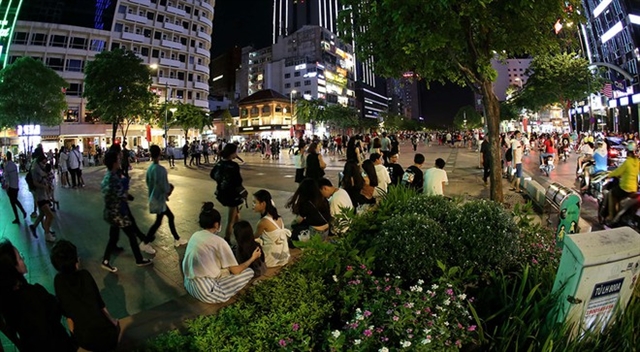 Life & Style
Life & Style

HCM City plans to open more pedestrian streets in central District 1 to meet locals and tourists’ entertainment and recreational demands.

|
| HCM City plans to have more pedestrian streets in the time to come. Photo courtesy of thanhnien.vn |
HCM CITY — HCM City plans to open more pedestrian streets in central District 1 to meet locals and tourists’ entertainment and recreational demands.
The city Department of Transport is collecting feedback on possible opening of new pedestrian streets downtown, including on Đồng Khởi, Lê Lợi, Quách Thị Trang, and Tôn Đức Thắng streets, and the Notre Dame Cathedral square area.
The project, funded by the HCM City Road Traffic Infrastructure Management Centre, aims to make central streets friendly for pedestrians after 2025.
Central District 1 is chosen to implement the project due to its unique grid of streets. A mixture of retail stores, cafes, restaurants, and modern and traditional markets can be found in this 300ha area.
Eight metro routes and three tram lines (or a monorail with a total length of 160km) are expected to be built in District 1 in the coming years. These would welcome 800,000 to 1.2 million commuters travelling back and forth between the main Bến Thành Station in District 1.
The Opera House and Hàm Nghi metro stations, together with nearby bus stops, would also become important points of contact in the area.
Of three pedestrian street proposals submitted by the investor, the second one has received the most support from relevant authorities.
According to the proposal, vehicles would be banned from Đồng Khởi Street on weekends, similar to the current traffic suspension on Nguyễn Huệ Pedestrian Street from 7:00pm to 11:00pm every Saturday and Sunday.
Lack of planning
This is not the first time HCM City has carried out research to launch a “super” pedestrian street in the city centre.
Since the beginning of 2017, the city Department of Transport has planned to transform Đồng Khởi, Huỳnh Thúc Kháng, Tôn Đức Thắng, Lê Lợi, Nguyễn Huệ, Phạm Ngọc Thạch, Võ Văn Tần, and Trần Cao Vân into pedestrian streets.
At the end of 2018, the city Department of Planning and Architecture proposed construction of a pedestrian-friendly area outside Bến Thành Market.
However, both of these proposals did not receive positive feedback from urban planning experts who disagreed with the way traffic would be organised near the streets.
Architect Ngô Viết Nam Sơn said the latest proposal has a good approach but lacks detailed planning.
In addition to ensuring smooth traffic connections, authorities need to determine an appropriate financial plan and management model before carrying out construction. Public-private partnerships would be important as well.
Existing pedestrian streets such as Nguyễn Huệ, Bùi Viện and Nguyễn Văn Bình, which use the state budget, have not been financially successful.
Sơn added that the proposed project emphasises the traffic situation but lacks planning and organisation of land-use space, which is key to development of any pedestrian street.
Though the four most important pedestrian zones in HCM City have been popular, authorities neglected to carry out frequent evaluations that would offer takeaways for future projects, he said.
Notably, Tôn Đức Thắng and Lê Thánh Tôn streets have experienced more traffic jams since Nguyễn Huệ became a pedestrian street.
Sơn suggested that the connection between Lê Lợi and Hàm Nghi streets should be further reviewed as there is currently no reasonable traffic plan to support locals’ lives.
“Considering the current state of HCM City’s traffic, it is necessary to carefully consider every step. The project should be divided into several pilot phases. For example, the first phase is to improve Nguyễn Huệ Street’s traffic infrastructure and connect it to Book Street, while the second phase would be linking Bùi Viện Street with the 23/9 Park,” Sơn said. VNS




